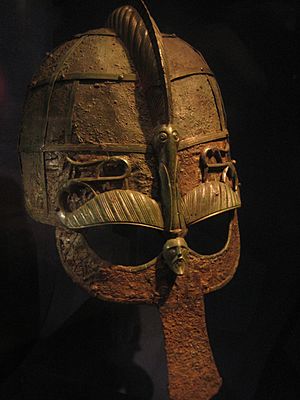Vendel facts for kids
Vendel is a small village in Tierp Municipality in Uppland, Sweden. It sits by Vendelsjön, a long lake connected to the Vendel river. This river later joins the Fyris river.
Long ago, Vendel was home to an important royal estate. This estate was part of Uppsala öd, a group of royal lands that helped support the Swedish kings in the Middle Ages. Many old items have been found here. These discoveries were so important that they gave their name to a time in history called the Vendel Period.
Vendel Church (Vendels kyrka) was likely first built in the late 1200s. Around 1450, brick arches were added to the church ceiling. The church is famous for its colorful paintings by an artist named Johannes Iwan, who worked in Uppland in the 1400s.
Contents
Exploring Ancient Graves
Between 1881 and 1883, a Swedish archaeologist named Hjalmar Stolpe (1841–1905) dug up 14 graves. These graves were found near the churchyard. Many of these burials were inside boats, some as long as 9 meters (about 30 feet)!
These boat graves were filled with amazing treasures. People were buried with weapons like fancy swords, helmets, and shields. They also had cooking pots, chains, beads, and tools.
Helmets and Shields from the Past
The helmets found in Graves 1, 12, and 14 at Vendel look very much like a helmet from an early 600s ship burial in Sutton Hoo, England. These helmets have metal plates with pictures of warriors. A shield from Grave 12 at Vendel is also very similar to the Sutton Hoo shield. It even has a metal strip that was made using the same tools as a piece found at Sutton Hoo.
The Vendel boats were found because of many ship rivets, which are like large nails used to hold boat parts together. Many animals, mostly horses, were also buried with the people. A later grave (Grave 3) held important parts of a horse's bridle. These graves date back to the late 500s to 700s.
The Mound of Ohthere
Near Vendel, at a place called Husby, there is a large dirt mound. Local stories call it Ottarshögen, which means "Ohthere's mound." Ohthere is a famous person from the old epic poem Beowulf.
In 1917, archaeologists dug into this mound. They found the remains of a powerful man who was buried in the early 500s. This was around the time Ohthere lived. Other graves from the same period, linked to Ohthere's family, are found at Old Uppsala.
Vendel's Place in History
Vendel has given its name to a period in the Scandinavian Iron Age, called the Vendel Age. It also named a style of art from that time, known as the Vendel style. Some people think that the ancient Germanic people called the Vandals, or at least their leaders, might have been connected to this place. Vendel is often linked with another important site nearby called Valsgärde.
The strong similarities between the finds at Vendel and the 27-meter (89-foot) ship burial at Sutton Hoo show a direct link. The people who made the armor found at both sites likely knew each other or used the same workshops. This connection helps us understand both places better. The Sutton Hoo burial is often thought to be for King Rædwald of East Anglia, who was a very powerful ruler in England from about 599 to 624 AD.
See also



